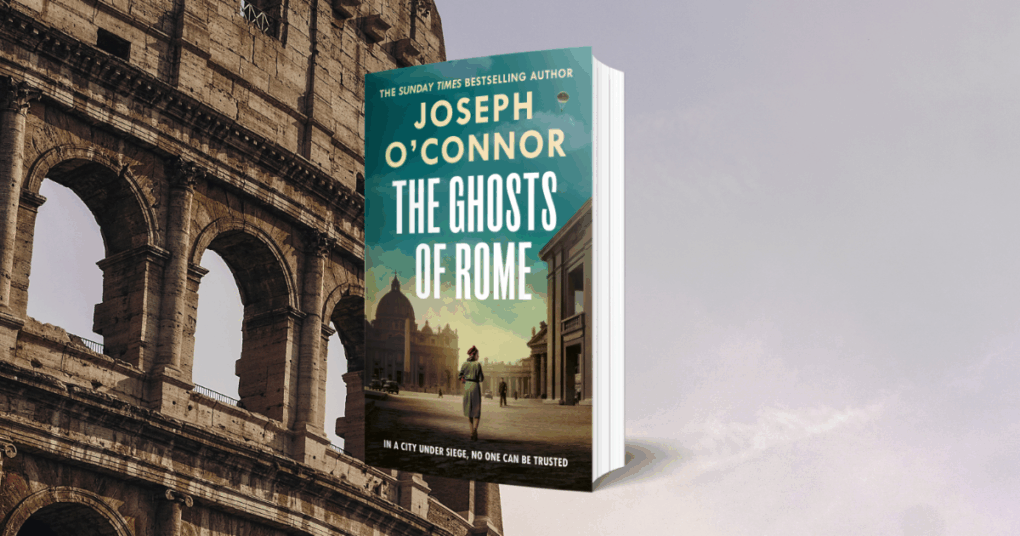The Ghosts of Rome
Joseph O’Connor
Harvill Secker
February 2023
304 pages
ISBN: 978-1787303874
The fiercely debated role of the Vatican during World War II remains a vibrant historical topic. Some criticise Pope Pius XII’s alleged failure to explicitly condemn the atrocities against Jews, while others argue that, as a neutral sovereign entity, the Vatican navigated a delicate balance between political pressures and its moral obligations as the spiritual centre of the Catholic Church. Less well-known is the Vatican’s role as the hub of a remarkable escape operation, not only for Jews but also for wanted communists, socialists, anti-fascists, and Allied soldiers hiding from the Nazis. As a neutral state, the Vatican’s 121-acre territory – the smallest country in the world – remained inviolable, even to the Nazi war machine. Following the fall of Mussolini and the Armistice between Italy and the Allies in late summer 1943, Vatican City became a unique safe haven and a centre of resistance against the Nazi occupation of Rome. Joseph O’Connor’s The Ghosts of Rome, the second volume in his projected trilogy set during this period, opens with a cinematic scene: on Ash Wednesday 1944, Allied bombers roar over the Eternal City, anti-aircraft fire erupts from the Villa Borghese, and a parachutist descends through the chaos, glimpsing the dome of St Peter’s and the Colosseum before landing in the heart of the besieged city. This arresting prologue encapsulates the novel’s blend of historical immediacy and dramatic flair, sustained throughout with vivid intensity.
Like its predecessor, My Father’s House (2023), The Ghosts of Rome explores the underground escape network led by Irish priest Monsignor Hugh O’Flaherty, an “Irish Oskar Schindler” credited with saving over 6,500 lives. His dangerous work, safe only within Vatican confines, involved a network of religious figures, communists, British soldiers, and Irish singer Delia Murphy (whose husband, Dr. Thomas J. Kiernan, was Ireland’s Ambassador to Rome from 1941to 1946). Defying Gestapo chief Herbert Kappler, who ordered his capture or death, O’Flaherty ventured out in disguise. Remarkably, after Kappler’s life sentence for the Ardeatine massacre, O’Flaherty was his only monthly visitor. Immortalised in the film The Scarlet and the Black (with Gregory Peck as O’Flaherty), the priest shunned fame but received high honours, including a CBE (UK), the Congressional Medal (US), and the distinction of being the first Irishman named Notary of the Holy Office. Several months after the events of My Father’s House, the clandestine group known as “the Choir” begins to fracture under the strain of their perilous work. O’Connor sustains narrative tension through a plot rich in deception, moral complexity, and psychological strain, portraying wartime Rome as a place of both physical danger and moral ambiguity. Outside Vatican City, any misstep or miscommunication could prove fatal, with the ever-present threat of Gestapo arrest and torture exacting a heavy psychological toll on rescuers and rescued alike. While grounded in historical reality, O’Connor notes in an endnote that the novel compresses events and invents or amalgamates characters, yet its deep engagement with historical experience is rendered with imaginative intensity.
Set during Lent – from Ash Wednesday to “Spy Wednesday,” the day tied to Judas’s betrayal of Christ – The Ghosts of Rome uses this liturgical structure to amplify its themes of sacrifice, betrayal, and moral reckoning, moving beyond mere atmosphere. Constructed in four acts, the novel incorporates retrospective interviews from the 1960s by principal characters, deepening characterisation and offering reflective narrative layers. Among the most compelling voices is Delia Kiernan, the Irish Ambassador’s wife, whose irreverent wit and political insight bring levity and defiance. Her sardonic remark in response to a Vatican official’s sartorial admonition – “Well, I wouldn’t want to clash with his Eminence” – is characteristic. While O’Flaherty remains central, the narrative foregrounds Contessa “Jo” Landini, a young widowed aristocrat and key agent in a storyline involving the parachutist from the opening. Her journey takes readers through diverse locales – from a disused sewer in the Forum to a makeshift operating theatre – culminating in a confrontation with Hauptmann, the Gestapo commander. The novel’s title reflects its thematic depth: the “ghosts” are not only fugitives and partisans navigating occupied Rome’s shadows but also the spectral presence of the city’s ancient past. O’Connor’s prose, rich with archaeological imagery, captures this layering of history, as when Jo, traversing subterranean spaces, reflects on “Twenty centuries above your head. Fifty centuries below” and “the stratum where Caligula flounced.” These moments underscore Rome’s essence, where ancient decadence and contemporary atrocity coexist.
In The Ghosts of Rome, O’Connor achieves a rare synthesis of historical realism, narrative propulsion, and literary allusion. His portrayal of occupied Rome is a stunning meditation on memory, the banality of evil, heroism, sacrifice, the human person, and resistance within a city marked by grandeur and horror. The novel’s vivid prose and moral complexity make it a powerful continuation of O’Connor’s trilogy, blending historical fidelity with imaginative depth.
About the Author: Gerard Scullion
Gerard Scullion studied law at Queen’s University Belfast and Trinity College Dublin and is a trainee solicitor based in Belfast. He writes periodically on the role of religion within law and diplomacy.

